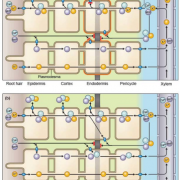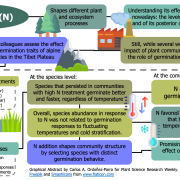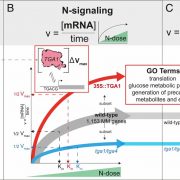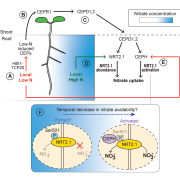Biosynthesis of redox active metabolites in response to iron deficiency in plants (Nature Chem Biol)
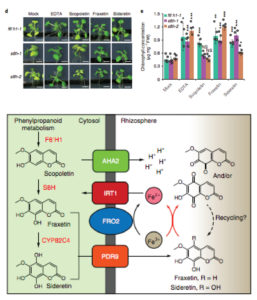 Iron is an essential but poorly bioavailable micronutrient that serves as a co-factor in many processes involved in electron- or oxygen-transfer. Land-plants evolved at least two distinct mechanism for iron uptake based on chelation of iron by phytosiderophores, that are produced only by grasses, or acidification of the rhizosphere and enzymatic reduction of iron chelates at the root surface. Rajniak et al. identified another iron acquisition mechanism in Arabidopsis, where redox-active metabolites, sideretin and fraxetin, are released from the roots upon iron deficiency in acidic and alkaline conditions respectively. Both metabolites were able to mobilize the insoluble iron and rescue the chlorotic phenotypes of the mutants and plants grown under iron starvation conditions. This work shows that release of the redox-active compounds is sufficient for iron uptake by plants. (Summary by Magdalena Julkowska) Nature Chem Biol. 10.1038/s41589-018-0019-2
Iron is an essential but poorly bioavailable micronutrient that serves as a co-factor in many processes involved in electron- or oxygen-transfer. Land-plants evolved at least two distinct mechanism for iron uptake based on chelation of iron by phytosiderophores, that are produced only by grasses, or acidification of the rhizosphere and enzymatic reduction of iron chelates at the root surface. Rajniak et al. identified another iron acquisition mechanism in Arabidopsis, where redox-active metabolites, sideretin and fraxetin, are released from the roots upon iron deficiency in acidic and alkaline conditions respectively. Both metabolites were able to mobilize the insoluble iron and rescue the chlorotic phenotypes of the mutants and plants grown under iron starvation conditions. This work shows that release of the redox-active compounds is sufficient for iron uptake by plants. (Summary by Magdalena Julkowska) Nature Chem Biol. 10.1038/s41589-018-0019-2


